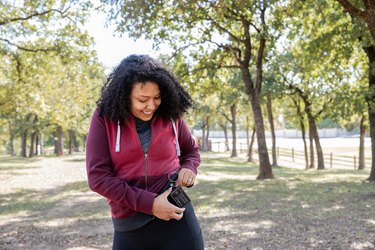
After being diagnosed with type 2 diabetes a year ago, California-based insurance executive Danny Ray knew it was important to start exercising as a way to manage the condition. The problem? He didn't want to do it.
"To say it was challenging is an understatement," Ray tells LIVESTRONG.com. For months, he tried to develop a routine but it never stuck, and he felt frustrated over his lack of motivation. At the same time, he knew that the more sedentary he became, the more health risks and complications would arise from his diabetes.
Video of the Day
Video of the Day
Research backs up the benefits of exercising if you have type 2 diabetes. For example, regular exercise makes your body more sensitive to insulin, which helps manage your diabetes, and can also help control blood sugar levels and lower risk of heart disease. But even knowing the advantages sometimes isn't enough to establish a consistent routine.
Finally, after trying a breadth of different workout strategies, Ray hired a health coach who was experienced in type 2 diabetes.
"I needed to just do what I was told and take the thinking out of it," he says. "I started with little things, like walking for 15 minutes three times a day and not eating three hours before bed. The coach and I tweak the plan weekly. Now I'm in a good-habit zone, and my blood sugar is under control."
Like Ray, many people with diabetes struggle with exercise motivation, and some might have the willingness, but don't know where to start. Here, trainers and diabetes experts who often work with clients who have type 2 diabetes offer tips on what to keep in mind.
1. Start With Simple, Familiar Activity
Putting together an extensive workout plan might seem appealing, but you're more likely to burn out quickly with activity that's too intense, too soon — or that's so unfamiliar that it increases your discomfort.
That's good advice for everyone, but for those with type 2 diabetes, it's especially important, according to Angie Victorio, RN, certified diabetes care and education specialist at DiaBettr.com. Complications like nerve damage, especially in the feet, make it harder to begin exercising, so she suggests light, simple exercises that can be done two to three times per week, like walking or yoga.
"This removes any confusion with not knowing what to do, while getting used to exercising on a regular basis," Victorio tells LIVESTRONG.com. "Also, because you start light and simple, it can be easier on any aches or pains and maybe even help strengthen muscles to alleviate that pain."
Also a benefit to staying on track and motivated: Wear the right shoes, suggests trainer Tom Miller, CPT, who coaches clients with type 2 diabetes.
"Wear athletic shoes that are in good shape and are the right type for your activity," he tells LIVESTRONG.com. "For instance, don't jog in tennis shoes, because your foot needs a different type of support when you run. Your sneakers should fit well and have plenty of room in the toe. Check and clean your feet daily for blisters, cuts, bumps, redness or sores even if you didn't work out that day. Let your doctor know if you notice any new foot problems."
2. Check Your Blood Sugar During and After Exercise
After a few weeks, you can gradually increase the intensity and duration of exercise to start seeing progress, Victorio says. However, it's crucial to be mindful of the effects of medications designed to lower blood sugar, like metformin or insulin.
"A person can — and should — still exercise while taking those medications, but should regularly check their blood sugar to make sure it doesn't drop too low, which means becoming hypoglycemic," she says. "Eating carbs before exercising can help prevent hypoglycemia, but if blood sugar tends to drop anyway, you should ask your doctor to adjust your dosage lower."
Checking blood sugar during exercise can help you understand how your body is responding, but it's also essential to continue checking every few hours as well, according to exercise physiologist Carmen Van Rensburg, who's developed exercise programs for people with type 2 diabetes.
"Exercise can lower blood sugar levels for up to 24 hours after a workout," she tells LIVESTRONG.com. "As a result, regular exercise may have an impact on prescription dosages. This can be especially true with resistance training, because it increases the sensitivity of muscles to insulin, allowing them to absorb more glucose."
3. Break Up Exercise Sessions Into Small Chunks
Another strategy for keeping blood sugar levels steady and maintaining motivation to exercise is to break up workouts into much smaller and more frequent activities, sometimes referred to as workout "snacks," Van Rensburg says.
Rather than choosing random times throughout the day to exercise — which can certainly cause your "I'll do it later" impulses to flare — she suggests tying these workout snacks to meals. For example, doing a few minutes of body-weight exercises or going for a short walk after eating. Not only will that create a sense of habit stacking and consistency, but it will improve blood sugar control as well, she says.
Ray's starting point of walking a few times daily felt achievable right away, to the point where he was ready to add more time to his walks within just a couple weeks of starting.
Most of all, it's important to see exercise as a way to manage your condition in a more effective way, especially because it can have a ripple effect on your energy levels and sleep quality, Ray says. Listen to your body, hire a trainer or other professional who is well versed in diabetes management and see the effort as a lifelong pursuit.
Was this article helpful?
150 Characters Max
0/150
Thank you for sharing!
Thank you for your feedback!